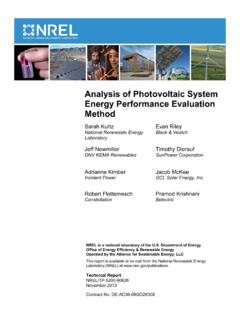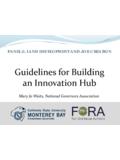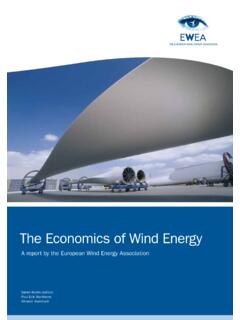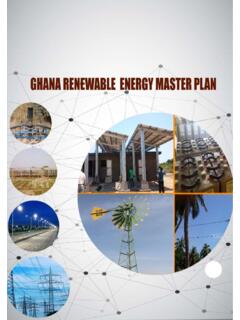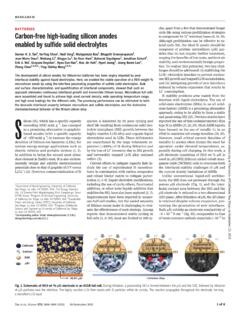Transcription of Science Projects in Renewable Energy and Energy Efficiency
1 I Science Projects IN Renewable Energy AND Energy Efficiency nrel /BK-340-42236 C October 2007 Some of the educational lesson plans presented here contain links to other resources, including suggestions as to where to purchase materials. These links, product descriptions, and prices may change over time. NOTICE This report was prepared as an account of work sponsored by an agency of the United States government. Neither the United States government nor any agency thereof, nor any of their employees, makes any warranty, express or implied, or assumes any legal liability or responsibility for the accuracy, completeness, or usefulness of any information, apparatus, product, or process disclosed, or represents that its use would not infringe privately owned rights.
2 Reference herein to any specific commercial product, process, or service by trade name, trademark, manufacturer, or otherwise does not necessarily constitute or imply its endorsement, recommendation, or favoring by the United States government or any agency thereof. The views and opinions of authors expressed herein do not necessarily state or reflect those of the United States government or any agency thereof. Printed on paper containing at least 50% wastepaper, including 20% postconsumer waste 1 Science Projects IN Renewable Energy AND Energy Efficiency A guide for Secondary School Teachers Authors and Acknowledgements: This second edition was produced at the National Renewable Energy Laboratory ( nrel ) through the laboratory s Office of Education Programs, under the leadership of the Manager, Dr.
3 Cynthia Howell, and the guidance of the Program Coordinators, Matt Kuhn and Linda Lung. The contents are the result of contributions by a select group of teacher researchers that were invited to nrel as part of the Department of Energy s Teacher Research Programs. During the summers between 2003 and 2007, fifty four secondary, pre-service, and experienced teachers came to nrel to do real research in Renewable Energy sciences . As part of their research responsibilities, each teacher researcher was required to put together an educational module. Some teacher researchers updated a previous nrel publication, " Science Projects in Renewable Energy and Energy Efficiency " (Copyright 1991 American Solar Energy Society).
4 These contributing teacher researchers produced new or updated Science project ideas from the unique perspective of being involved in both education and laboratory research. Participants that contributed to this publication include Nick Babcock, Jennifer Bakisae, Eric Benson, Lisa Boes, Matt Brown, Lindsey Buehler, Laura Butterfield, , Don Cameron, Robert Depew, Alexis Durow, Chris Ederer, Brigid Esposito, Linda Esposito, Doug Gagnon, Brandon Gillette, Rebecca Hall, Brenna Haley, Brianna Harp, Karen Harrell, Bill Heldman, Tom Hersh, Chris Hilleary, Loren Lykins, Kiley Mack, Martin Nagy, Derek Nalley, Scott Pinegar, Jennifer Pratt, Ray Quintana, Steve Rapp, Kristen Record, Emily Reith, Leah Riley, Nancy Rose, Wilbur Sameshima, Matthew Schmitt, Melinda Schroeder, Tom Sherow, Daniel Steever, Andrea Vermeer, Brittany Walker.
5 Dwight Warnke, Mark Wehrenberg and Rick Winters. Finally, this book owes much to the original authors and advisors of the 1st Edition in 1991. They include Ann Brennan, Barbara Glenn, Suzanne Grudstrom, Joan Miller, Tom Milne, Dan Black, Hal Link, Bob Mconnel, Rick Schwerdtfeger, Patricia Bleil, Rosalie Craig, Steve Iona, Larry Jakel, Larry Lindauer, Bob McFadden, Beverly Meier, and Helen Wilson. 2 The National Renewable Energy Laboratory ( nrel ) is the nation's premier laboratory for Renewable Energy research and development and a leading laboratory for Energy Efficiency R&D. nrel is managed by Midwest Research Institute and Battelle. Established in 1974, nrel began operating in 1977 as the Solar Energy Research Institute.
6 It was designated a national laboratory of the Department of Energy (DOE) in September 1991 and its name changed to nrel . nrel develops Renewable Energy and Energy Efficiency technologies and practices, advances related Science and engineering, and transfers knowledge and innovations to address the nation's Energy and environmental goals. nrel 's Renewable Energy and Energy Efficiency research spans fundamental Science to technology solutions. Major program areas are: Advanced Vehicle Technologies & Fuels (Hybrid vehicles, fuels utilization) Basic Energy sciences Biomass (Biorefineries, biosciences) Building Technologies (Building Efficiency , zero Energy buildings) Electric Infrastructure Systems (Distribution & interconnection, thermal systems, superconductivity) Energy Analysis Geothermal Energy Hydrogen & Fuel Cells (Production, storage, infrastructure & end use) Solar (Photovoltaics, concentrating solar power and solar thermal) Wind Energy 3 Contents Introduction.
7 4 The Role of the Teacher .. 7 How to Do a Science Project .. 14 Project Ideas .. 18 What Does the Sun Give Us .. 19 Photovoltaics and Solar Energy .. 31 Material and Chemical Processing .. 56 Modeling the Process of Mining Silicon Through a Single-Displacement/Redox Reaction .. 60 Utilizing Photovoltaic Cells and Systems .. 73 Photosynthesis and Biomass Growth .. 85 Statistical Analysis of Corn Plants and Ethanol Production .. 98 Biofuel Production .. 103 Renewable Energy Plants in Your Gas Tank: From Photosynthesis to Ethanol .. 110 Cell Wall Recipe: A Lesson on Biofuels .. 129 Reaction Rates and Catalysts in Ethanol Production .. 140 A Pre-treatment Model for Ethanol Production Using a Colorimetric Analysis of Starch Solutions.
8 151 The Bio-Fuel Project .. 158 Biofuel Utilization .. 193 Wind .. 198 Hydropower .. 207 Ocean Power .. 211 Alternative Fuels Used in Transportation .. 216 Computer Based Energy Projects .. 226 Environmental Aspects .. 231 4 Renewable Energy technologies are clean sources of Energy that have a much lower environmental impact than conventional Energy technologies. Importing Energy is costly, but most Renewable Energy investments are spent on local materials and workmanship to build and maintain the facilities. Renewable Energy investments are usually spent within the United States frequently in the same state, and often in the same town. This means your Energy dollars stay at home to create jobs and fuel local economies, rather than going overseas.
9 After the oil supply disruptions of the early 1970s, our nation has increased its dependence on foreign oil supplies instead of decreasing it. This increased dependence impacts more than just our national Energy policy. We can be certain that electricity use will grow worldwide. The International Energy Agency Projects that the world's electrical generating capacity will increase to nearly million megawatts by the year 2020, up from about million in 2000. However, the world's supply of fossil fuels our current main source of electricity will start to run out between the years 2020 and 2060 according to the petroleum industry's best analysts.
10 Shell International predicts that Renewable Energy will supply 60% of the world's Energy by 2060. The World Bank estimates that the global market for solar electricity will reach $4 trillion in about 30 years. Other fuels, such as hydrogen and biomass fuels, could help replace gasoline. It is estimated that the United States could produce 190 billion gallons per year of ethanol using available biomass resources in the USA. And, unlike fossil fuels, Renewable Energy sources are sustainable. They will never run out. According to the World Commission on Environment and Development, sustainability is the concept of meeting "the needs of the present without compromising the ability of future generations to meet their own needs.










